Russian Stage Design--1906-1930
Neo-Realism to Socialist Realism (29 - 39)
 #40
#40
Nikolai Sapunov designed the sets and costumes for Meyerhold's 1906
production of Alexander Blok's "The Fairground Booth". This sketch is for the beginning of
the play, and depicts the mystics sitting at a table in the center of the internal stage. In the
actual production, cardboard cutouts were used to hide the mystics' bodies, and only their
heads and hands could be seen through holes in the cardboard. Pierrot is sitting slumped to
the side of the mystics.
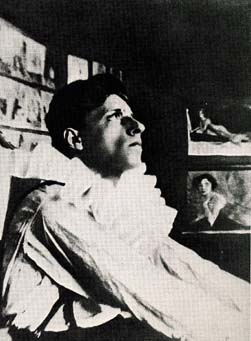 #41
#41
Vsevolod Meyerhold was a great actor in addition to being one of the
most influential directors in history. This photograph is of Meyerhold in the costume of
Pierrot that he wore in his production of Alexander Blok's play "The Fairground Booth" of
1906.
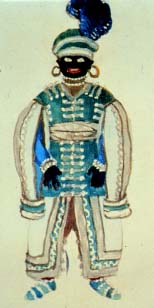 #42
#42
In the Fall of 1910, Sergei Diaghilev and Igor Stravinsky convinced Alexandre Benois
to write the scenario (in collaboration with the composer) and to design costumes and sets
for an original ballet to be entitled "Petrushka". The ballet premiered in 1911, and was
perhaps the most successful and influential Ballets Russes production. This is Benois'
design for the costume of the Moor, Petrushka's successful rival and eventual murderer.
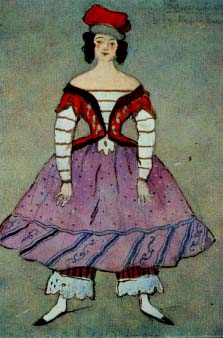 #43
#43
This is Benois' design for the Ballerina's costume.
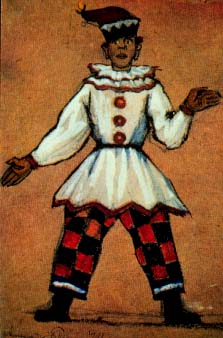 #44
#44
This is Benois' design for Petrushka's costume. Compare to the
costume Meyerhold wore as Pierrot (#41) as well as the woodcut depicting a traditional
Petrushka (#45).
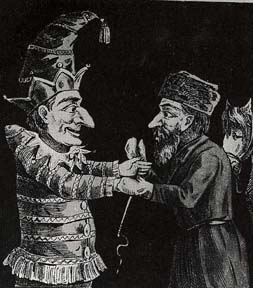 #45
#45
This late-19th-century woodcut shows the Russian fairground version
of Petrushka. Note his exaggerated facial features and gaudy costume. In this scene,
Petrushka bargains with a gypsy for a horse. The horse subsequently throws Petrushka,
and in revenge he beats the gypsy to death, starting a whole string of violent conflicts that
generally end with Petrushka being dragged off to hell.
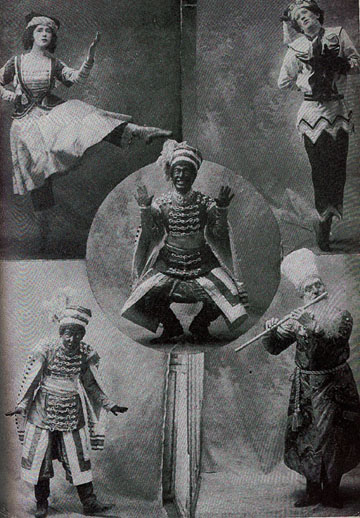 #46
#46
This photomontage appeared in a Paris fan magazine devoted to the
Ballets Russes. We see, in costume, the dancers who created the lead roles in "Petrushka".
At the top left is Tamar Karsavina in the role of the Ballerina. The top right is Nijinsky in
the role of Petrushka. The bottom right is the Magician of Enrico Cechetti, and, on the
lower left as well as in the center inset, the Moor.
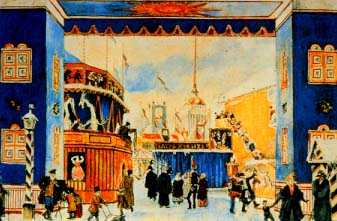 #47
#47
Benois' designs were remarkable not merely for their expressivity but
also for their vibrant color. This is the design for Act 1 of Petrushka, which takes place
during the Shrovetide carnival. Compare Benois' depiction of the scene with that of
Kustodiev (#48). In the central part of the background, one can see the Admiralty spire,
which identifies the setting of the ballet as St. Petersburg. Note the stage within a stage at
the center. It is from behind the blue curtain that the Magician will summon the puppets of
the Moor, the Ballerina, and Petrushka to life.
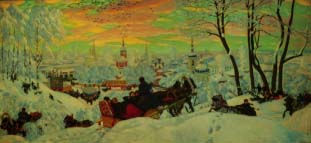 #48
#48
Boris Kustodiev (1878-1927) was known for his colorful depictions of
Russian village life. This picture, entitled "Shrovetide" (1916) captures the gaiety of the
Russian mardi gras period that is featured in the ballet "Petrushka".
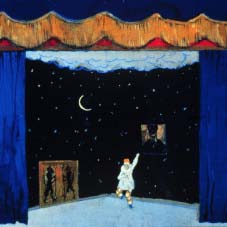 #49
#49
The two interior scenes of the ballet depict life within the smaller, on-
stage theater. This is Benois' design for Petrushka's room.
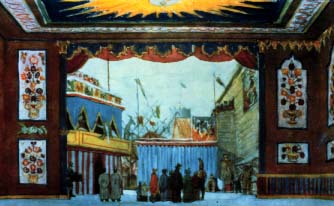 #50
#50
Act 4 of "Petrushka" moves back out onto the streets of St. Petersburg.
Listen to an excerpt from the folksong "Along the Peter Road" (as arranged by
Rachmaninoff)
Listen to Stravinsky's version of the same melodic material in Act 4 of
Petrushka.
(To listen to these files, you must download the
free the RealAudio Player and install it
on your computer.)
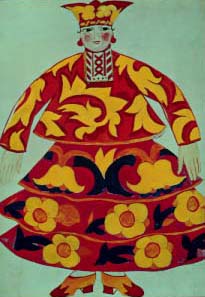 #51
#51
Goncharova also designed for the Ballets Russes. This costume was
drawn for Diaghilev's Paris production of Rimsky-Korsakov's opera "The Golden
Cockerel" (1914). The vibrant colors were typical for Goncharova, and they were much
appreciated by Paris audiences who saw in them an example of Russian vital barbarism.
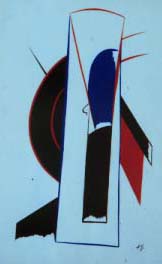 #52
#52
In emigration after 1917, Natalia Goncharova painted this witty cubo-
futurist "portrait" of the impresario Sergei Diaghilev.
 #40
#40
 #41
#41
 #42
#42
 #43
#43
 #44
#44
 #45
#45
 #46
#46
 #47
#47
 #48
#48
 #49
#49

 #51
#51
 #52
#52